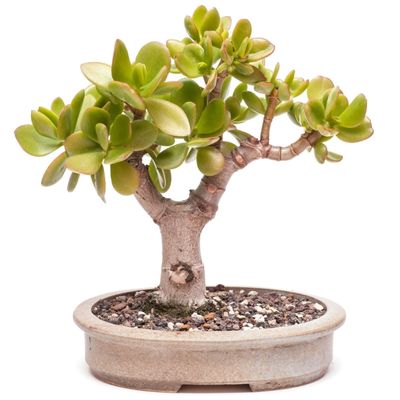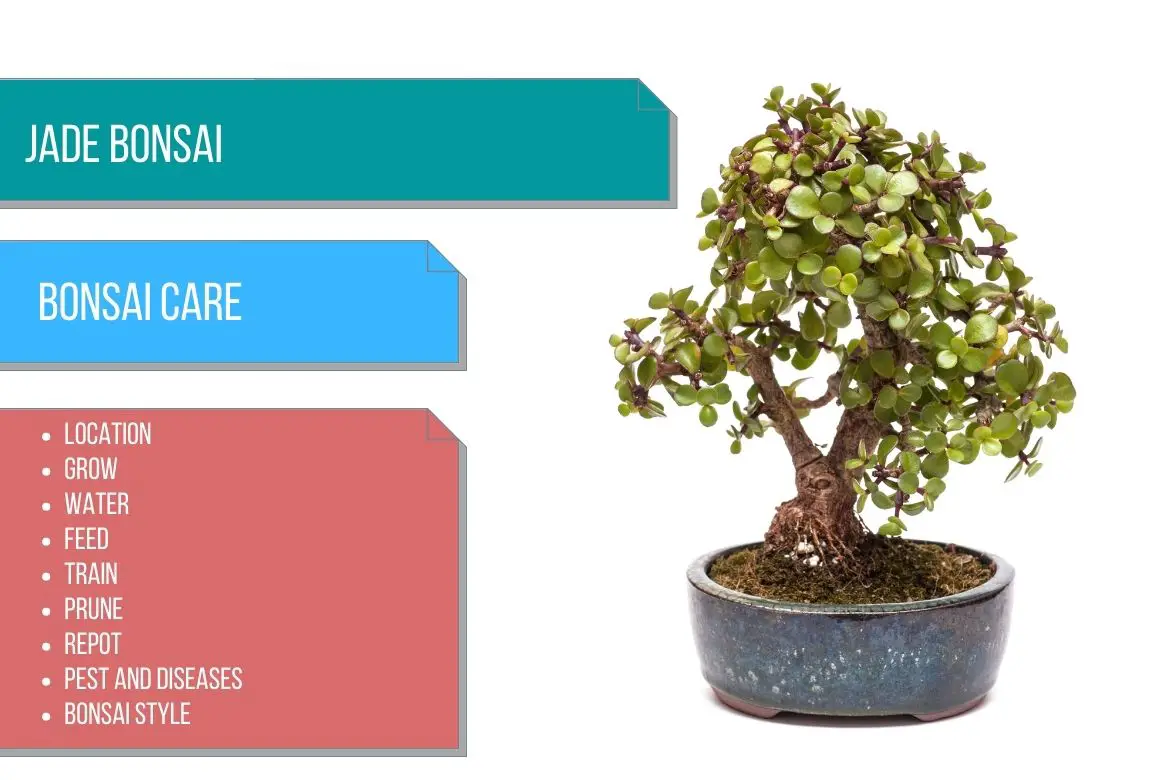
Jade tree / Money tree
(Crassula)
Country of Origin : South Africa
Bonsai Styles : Informal upright, twin trunk
Zone : 10
Commonly known as the money tree or jade plant, it is not a tree but an evergreen succulent.
However, they have a tree-like growth habit with sturdy trunks and distinguishable branches.
The green rounded leaves of the tree are small and have a glossy smooth structure. Also, the leaves have a particularly fleshy structure.
The leaves are borne in pairs, regularly spaced, and at right angles to the previous pair.
It is possible to find many species of crassula, but there are 2 species which are used for making bonsai – Crassula arborescens and Crassula ovata (syn. Crassula portulacari).
As an added advantage, Crassula ovata has small leaves and a trunk and branches that can be wired into any shape. Whereas, Crassula arborescens leaves have a jade green color and develop a red tinge in full sun.
The tree is also adorned with pale pink flowers. These flowers appear in winter and in some regions they appear in early spring.
Jade plants make interesting indoor bonsai trees that look like trees. Jade trees, depending on the species, can be trained into bonsai of all sizes – from small (mame) to large bonsai specimens.

It is one of the most suitable species for beginner bonsai growers. Growing this tree doesn’t require extensive knowledge of horticulture. It’s good for learning how plants grow and how they respond to pruning.
Even a beginner can achieve a good “tree-like” bonsai by practicing basic pruning techniques. (Even without wire training).
This tree definitely gives the experience to move on to the more challenging bonsai projects.
Furthermore, jade bonsai trees are easy to grow since they require very little water. For several weeks, they can be left unattended.
Best location to keep Jade bonsai
Due to its semi-desert habitat, it is able to thrive in the hottest temperatures. Also, it is adapted to the low night temperatures of the desert.
Due to their succulent nature, succulents are prone to frost, which will almost certainly kill them in a short period of time.
However, as long as the soil is not wet, it will tolerate occasional light frosts.
There are some plants that are semi-hardy and may be suitable for greenhouses. However, most of them are quite happy outdoors as long as they are slowly acclimated.
You can keep them in full sun.
The minimum temperature they can withstand is 41-45°F (5-7°C).
In order for crassula bonsai tree to flourish as indoor bonsai, they need to be kept in a bright position, though direct sunlight is not essential for them to flourish.
Refer sunlight requirements for indoor plants for more indoor gardening ideas. Also, refer to do bonsai trees need sunlight for more indoor and outdoor bonsai location ideas.
Propagation of Jade tree
Jade tree can be propagated easily by using cuttings at anytime.
The cuttings develops roots pretty quick when planted in a soil which is sandy.
Watering Jade Bonsai
Jade bonsai tree needs little moisture in summer, so water moderately.
Let the soil dry between the watering sessions.
In the event of over-watering, the leaves of these species will become large and floppy, causing the tree to become top heavy and unstable, or rot the roots.
During winter, give just enough water to prevent wrinkling of leaves. Your Crassula bonsai should be watered about every three to four weeks in winter.

In case your Jade bonsai tree falls off because of root decay (because of excessive watering and waterlogging), don’t worry. You can still bring it back.
Prune the rotting base of the trunk. Leaving no decayed tissues.
Let the trunk dry for a few days so that the wound dries out. As the wound heals and dries, you will notice that the tissue around the wound will start curling inward.
Plant the trunk in the soil (like you do while planting a cutting).
However, keep the soil just moist. Because, unlike other tree species (which only root when the soil is damp), Jade tree produces roots to seek water in the soil.
Read watering bonsai tree for more details about immersion technique.
Wiring Jade Bonsai
The pliable branches of Crassula ovata allow it to be easily wired into any shape. You can apply the wires at any time of the year.
Wires can be left on the branches for about one year.
On the other hand, Wiring does not work well on Crassula arborescens, so this species is best shaped by pruning only.
Pruning Jade Bonsai
When to prune Jade bonsai?
How to prune Jade bonsai?
If necessary, the crassula bonsai can be defoliated and pruned very hard. Hard pruning the indoor bonsai is recommended if you wish to change the structure of the bonsai tree.
Pruning intensively always results in new shoots emerging from the old internodes of jade plants.
Each fleshy leaf has a dormant bud at its base. This dormant bud will always produce a new shoot when pruned back to that point.
Branches can be pruned at any time while the tree is actively growing. Prune the branches back to 2 to 3 pairs of leaves. The ramification of fine branches will be encouraged as a result.
Create a treelike structure by pruning leaves from the trunk and the base of old, lower branches.
Pinching Jade Bonsai
The tips of new shoots should be pinched back when they reach the desired length in spring. By this you can maintain the shape of the tree.
Repotting Jade Bonsai
When to repot Jade bonsai?
Crassula bonsai trees can be repotted every second year in spring.
However, it is possible to grow crassula bonsai for four or five years in the same bonsai container when grown indoors.
The leaves of a plant will become large and the internodes will become long when the jade tree is repotted frequently.
You can use a basic sandy, free-draining bonsai soil mix as a potting soil. However, you can also use a cactus mix.
Or, make a bonsai soil mix with 30% grit and 70% organic matter.
You can also make a mix with leaf mold, loam and sharp sand in the ratio of 1:1:1.
Must Read: Bonsai Soil Recipes
Must read : Choosing the right bonsai container
Feeding Jade Bonsai
Half-strength balanced fertilizer should be applied while the plant is actively growing.
Read more about applying feed to flowering bonsai in bonsai fertilizer and its application.
Diseases and pest of Jade Bonsai
This tree is susceptible to scale insects, which should be treated with a weak systemic insecticide. Scale insects are especially attracted to the juicy stems of the tree.
It is usually possible to remove aphids by hand. Treatment with a systemic insecticide is necessary if the infestation persists.
However, keep in mind that sometimes insecticides are not that effective on these plants. So, manual removal of pests is sometimes the best option.
Due to the fact that crassula bonsai trees are not repotted every year, vine weevils can be a problem. Late in the spring, water nematodes into the bonsai soil.
Other than that, jade plants are usually trouble-free.
Jade bonsai care
Unless the roots are allowed to become too wet, the crassula trees are practically indestructible.
However, despite the fact that Crassula can withstand the occasional light frost, don’t assume that all examples will be equally hardy.
It indicates that the jade plant has become too dry if its leaves begin to wrinkle.
Water is Crassula trees worst enemy if not supplied properly. If its roots are constantly wet, they cannot resist decay. Plants may appear to be perfectly healthy until, suddenly one day, they fall.
What to look for when buying Jade Bonsai
The majority of Crassula bonsai specimens sold are very small and untrained.
Just make sure that the bonsai soil is free draining and the roots are healthy and firmly holding to the soil in the bonsai pot.

